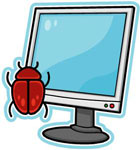Bug Identification Key
Field Guide > Bug Identification Key
Start Online Bug Identification Key
What is a Key?
In science and biology, a "key" is a written tool used for accurate identification of such things as plants, animals, and rocks. In this section, the key is used to identify insect orders.
What is an Insect Order?
For your 4-H entomology collection, you need to know to which “order” each of your insects belongs. As you may have learned in science or biology class, an “order” is a group of related animals. All mammals, for example, belong to the order Mammalia.
Because there are so many different kinds of insects (1 million and counting), they are divided up into over 30 different orders. You are probably familiar with many common insect orders already. All of the flies (including house flies, mosquitoes, horse flies, and others) belong to the order Diptera. All moths and butterflies are in the order Lepidoptera. The beetles are in Coleoptera. These are just a few examples.
The key included presented in this section will give you the characteristics to accurately tell the difference between insect orders. With a little practice, you will be able to recognize most insects without using a key.
Taking a Closer Look
Because insects are so small, seeing the differences between them is difficult, and from a distance many insects look very similar. But when you examine them more closely, the differences are easier to see. Keep this in mind when you are trying to identify insects in your collection: to get an accurate identification, and to see many of the characters mentioned in the key, you may have to hold an insect close to your eyes or use a magnifying glass or a microscope.
Why use a Key?
Sometimes, you can identify an insect quickly by comparing it to pictures in field guides or on the Internet. Pictures are a great tool, but the use of a key is essential to guarantee that your identification is accurate. Why? Because some insects, even ones from separate orders, can look almost exactly alike.
Example: there are many flies (order Diptera) that look almost exactly like wasps (order Hymenoptera). But if you use a key to identify your fly, you will find that it has 1 pair of wings: all flies have 1 pair of wings and wasps have 2 pairs of wings.
Key to Adult Insects Only
Remember - immature insects and adult insects are often very different. The key included in this guide is only useful for keying adult insects to order. Also, this key only briefly covers other creatures related to insects, like spiders, sowbugs, and centipedes.
Insect Body Parts
To use this key you will need to know the basic anatomy – the body parts – of insects. Use this labeled picture of a grasshopper as a reference when the key asks you to look at certain body parts. Most insects will have all of these body parts, with a few exceptions (many insects don’t have wings, for example, and most insects other than grasshoppers and crickets do not have ears).

Start Online Bug Identification Key
Click here for paper version of the key - University of Kentucky
Note: Information in this section is based mainly on the "Kentucky 4-H Entomology: Key to Common Insect Orders." Used with permission.

